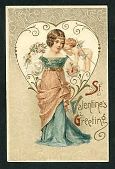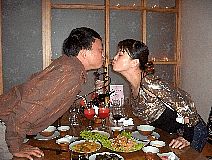
|
Celebrations Around the World  Shop with Valentine's Day gifts In the United States of America, Valentine's Day is very popular as well as heavily commercialized. The most common tradition is to exchange cards expressing love or even the common "Valentine" which is a specialized card. A Valentine also refers to the person giving or receiving the card, so these cards normally carry the phrase "Please be my Valentine". The exchanging of valentines is very popular among children during classroom parties in their schools. Simple poetry is often exchanged as well, with the most common lines to begin it being "Roses are red, Violets are blue". As part of the commercialization, small gifts are also exchanged. The most common of these are roses and chocolate given to women by men, but everything from stuff animals to diamond jewelry is also given. The reference to "love" has also been expanded to include both the platonic love between friends to the intimate kind between spouses and lovers. Special dances and dinners are also organized for lovers to spend time together. In Britain, the exchange of cards and gifts is done like in the US, but children also sing special songs related to the occasion for which they are rewarded with candy, fruit, or even money. Composing poetry is also done at a much greater level than in the US, especially since the first romantic poetry associated with Valentine's Day was written in Britain. The English also bake special "valentine buns" as a means of celebrating fertility.  Valentine postcard, circa 19001910 Valentine's Day was once celebrated as an open air Spring Festival in Italy, but it hasn't been celebrated like that for centuries. Instead, it is now treated as other holidays imported from the US, like Halloween, and is celebrated mainly by young people in the same way as the US. However, it is more designated toward lovers, and so family members and friends do not normally exchange gifts. One aspect of this holiday that Italy and Britain shared was that unmarried girls were supposed to wake up before sunrise and stand by their windows, for it was believed that the first man an unmarried girl sees on Valentine's Day would marry her within a year. The French once had a Valentine custom called "drawing for". It involved unmarried individuals to enter houses which faced each other and calling from one window to the other, pairing off with a chosen partner. If the male was not very happy with his "drawn" valentine, he would leave her. At the end of the day, a bonfire was lit so that the rejected women could burn images of the ungrateful man and verbally abuse him aloud. Due to the amount of nastiness this custom caused, however, the French government finally banned it. In modern France, they celebrate this day by the exchange of cards and gifts as in other countries. In Germany, the custom is that the man of an unmarried couple presents his beloved with flowers on February 14th. Gifts and messages are also exchanged, but these are not restricted to Valentine's Day and can be given on any joyous occasion.  A special card is used in Denmark called a "lover's card". Earlier versions of these were transparent and when held up to light showed the image of a lover handing his beloved a present. Now, any Valentine's Day card is called a "lover's card". Another tradition the Danish practice is the sending of pressed white flowers called Snowdrops to their friends and loved ones. Like Italy, however, Valentine's Day is generally viewed as being for the young, between the ages of 15 and 30. In Japan, Valentine's Day is actually broken into two different dates. On February 14th, women give gifts to the boyfriends, spouses, lovers, or any many close to them. This is then rewarded on White Day, March 14th, when the men who received such gifts then pamper the women who gave them. Chocolate giving from women is a very strong custom on these days. Women give close male friends and bosses "giri-choco" but it has no romantic association. "Giri" means "obligation" and women make sure to gift all men close to them with this since it is embarrassing for a man to not receive any. For boyfriends, lovers and husbands, "hon-mei" is given. Many women even feel that it isn't true love if this chocolate is bought, so they prepare them personally. "Hon-mei" means "prospective winner", so any man receiving these feels very lucky. The Koreans share the same tradition of splitting Valentine's Day and exchanging chocolates, with one notable exception. On the "White Day", many men confess their love for the first time to their valentines. For those people that have no particular romantic partners or interests, there is a third date set aside. On April 14th, or "Black Day", these people get together and eat Jajang noodles, which are black.  One custom in Scotland is to gather an equal number of unmarried men and women and have them write their names on pieces of paper which are then placed in two hats, one for men and one for women. The women then draw the names of men and the men draw the names of women, as a means of creating couples. However, since it is very unlikely that any of these names would match correctly, if they don't, the male would go with the female that selected his name. Gifts are then given to the women, and those women pin the name of their partner to their clothes, either over the heart or on their sleeves. This is often followed by a dance and sometimes, at the end of the festival, some marriages take place. These are just some of the ways Valentine's Day is celebrated around the world. More countries have begun to celebrate it in recent years, adopting the US and British ways of exchanging gifts and cards as well as creating their own traditions. Be sure to spend time with your loved ones this Valentine's Day! |
| Celebrations - Valentine's Day | ||||||||||||||
| Writer: | Sonja Krüger | |||||||||||||
| Images: | ||||||||||||||
| ||||||||||||||
| Sources: | ||||||||||||||
| ||||||||||||||
All images are Copyright - CC BY-SA (Creative Commons Share Alike) by their respective owners, except for Petey, which is Public Domain (PD) or unless otherwise noted.
comments powered by Disqus



















